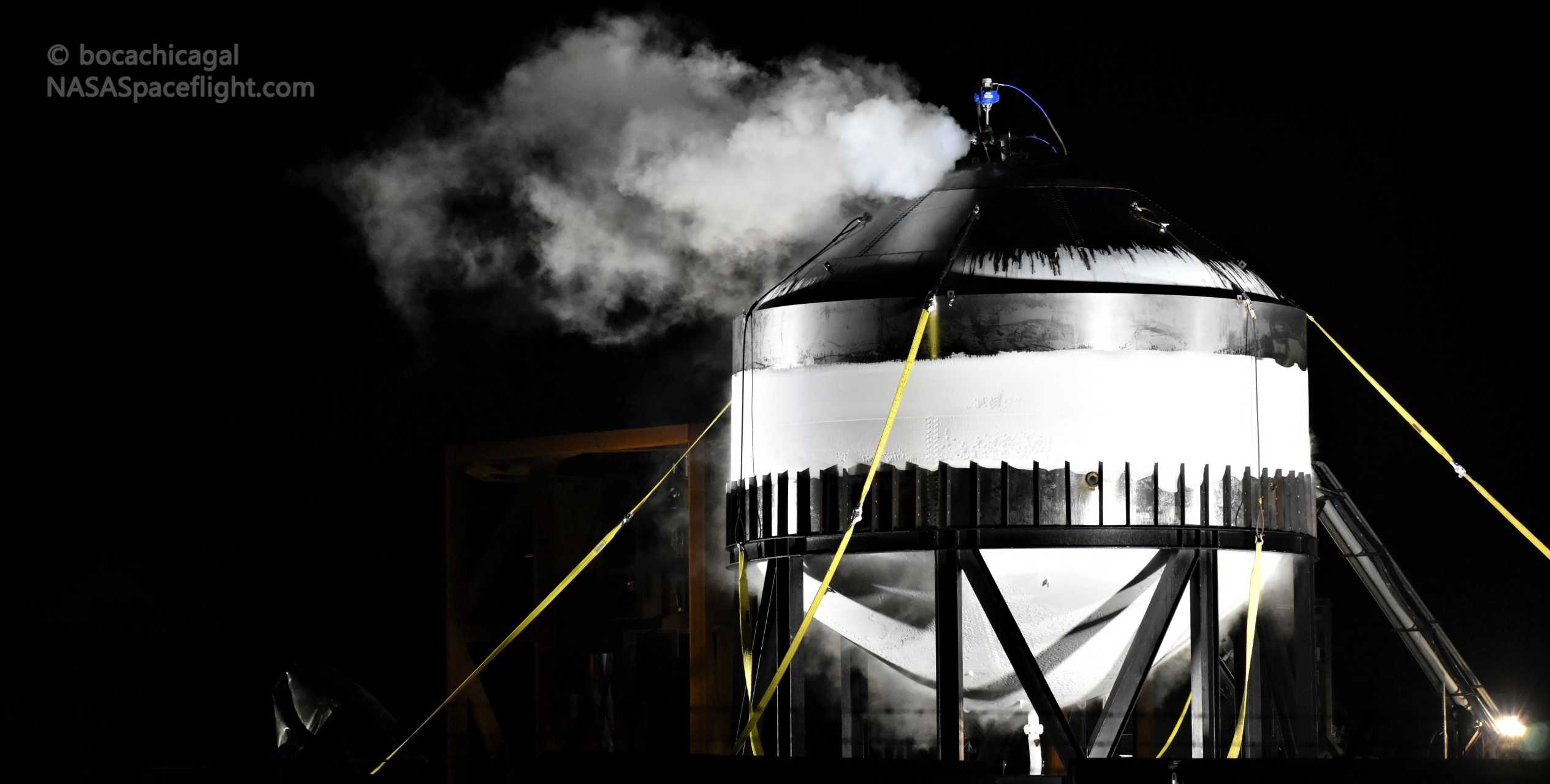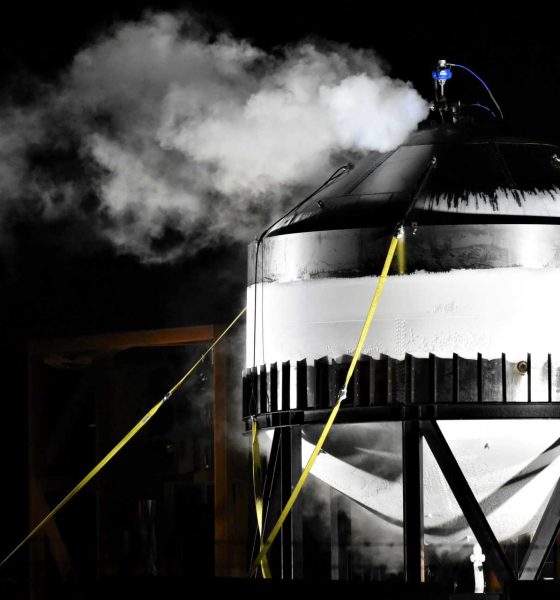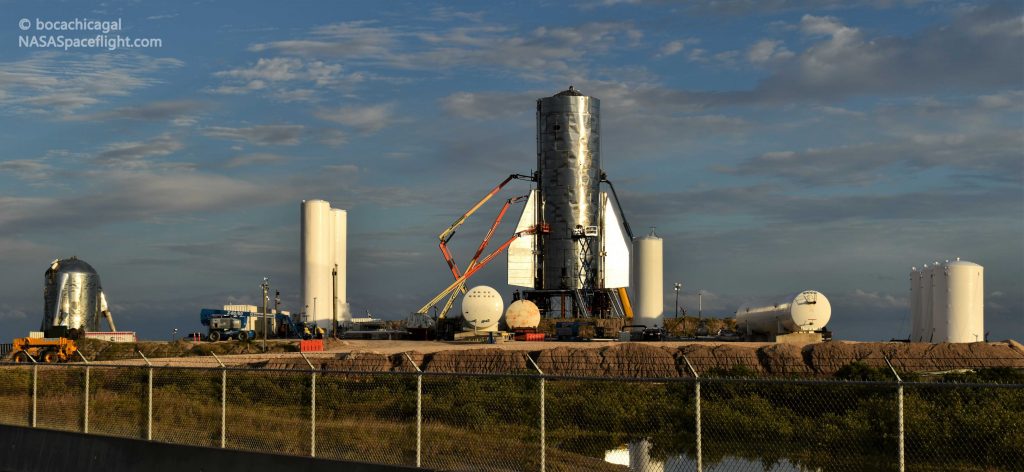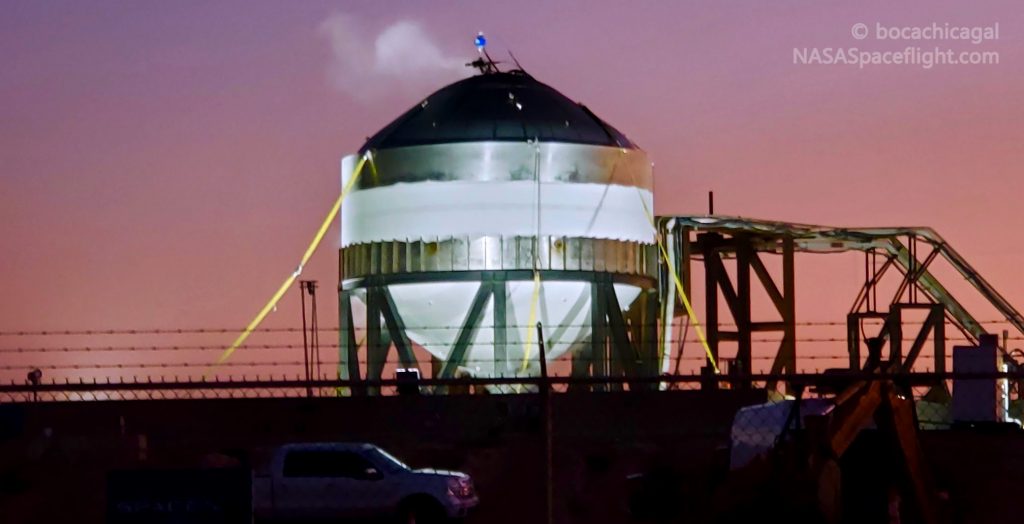

News
SpaceX Starship just aced another explosive tank test and Elon Musk has the results [video]
SpaceX has successfully repaired a leak in a Starship prototype, filled the giant tank with an ultra-cold liquid, and pressurized it until it (spectacularly) popped — and Elon Musk has the preliminary results.
Designed to determine the quality and capabilities of SpaceX’s current manufacturing and integration procedures, the company technically performed its first explosive Starship test back in November 2019, when it decided that the first full-scale prototype – Starship Mk1 – was not fit to fly. Instead of entering the final stages of assembly with a vehicle that SpaceX simply couldn’t be sure would survive the rigors of even a low-stress flight test, the massive vehicle’s tank section was installed at the company’s South Texas launch facilities and pressurized with liquid nitrogen until it burst.
Built almost entirely unprotected on the South Texas coast, Starship Mk1 simply wasn’t up to the standards needed for SpaceX to trust that the giant rocket would survive the stresses of flight. Much like Falcon 9, Starship and its Super Heavy booster will be structurally stable while their tanks are empty, but a great deal of additional (and absolutely critical) structural strength will be added by pressurizing those tanks with a combination of liquid and gaseous propellant. Achieving the required pressures, however, can be a major challenge and the purpose of test tanks like the one above is to prove that the company is up to the challenge. According to Elon Musk, after tonight’s test, SpaceX almost certainly is.
In all truthfulness, the real start of explosive Starship pressure testing actually happened all the way back in 2017 when SpaceX intentionally pressurized a vast 12m-diameter (40 ft) carbon composite tank until it popped. Back then, Starship was known as Big Falcon Rocket (BFR) and was designed to use carbon fiber composites for nearly all of its structure — propellant tanks included.
According to CEO Elon Musk, said carbon composite tank met SpaceX’s expectations (i.e. the necessary pressures for flight) and was pushed to 2.3 bar (33 psi) before it burst in a rather spectacular fashion, launching almost 100 m (300 ft) into the air. Around 2.5 years after that test, it’s believed that Starship Mk1 reached something like 3-5 bar before it popped, and Musk recently revealed that the new steel Starship and Super Heavy designs will require tanks pressures of at least 6 bar (90 psi) to survive the stresses of orbital flight.
Thankfully, although Starship Mk1 didn’t achieve those necessary pressures, the prototype was effectively a worst-case scenario for manufacturing and assembly, revealing the rather unsurprising reality that SpaceX needed to improve its uniquely sparse methods of production and assembly. Although the stainless steel SpaceX settled on for Starship is much more tolerant than aluminum or most other metals when it comes to welding, steel welds still suffer if exposed to more than a minor breeze, as wind will cause the welded metal to cool less than uniformly.


With the latest series of steel Starship tank prototypes, SpaceX has significantly improved its production infrastructure, finally offering at least a semblance of protection against the elements. Based on the first test tank’s explosive performance on January 10th, those improvements have paid dividends. According to Musk, test tank #1 made it all the way to 7.1 bar (105 psi) before it burst and test tank #2 reportedly did even better.
Meanwhile, SpaceX’s South Texas team has already finished and partially tested a second Starship test tank, ultimately reaching 7.5 bar with water before a small leak sprung on January 27th. Over the last 24 hours, technicians have worked to repair the apparently minor damage and began filling the Starship tank with ultra-cold liquid nitrogen (boiling point: -196°C / -320°F) around 5:30 pm CST (23:30 UTC) on January 28th. After filling with liquid nitrogen, SpaceX kept the steel tank topped off for several hours. The likely purpose behind that otherwise odd move: something called cryogenic hardening. By exposing certain types of steel to liquid nitrogen temperatures, the material can be dramatically strengthened in some regards.

Around four hours after Tuesday evening’s testing began, the Starship tank prototype appeared to develop a significant leak in its upper dome, hemorrhaging liquid nitrogen that immediately produced large clouds after coming into contact with the South Texas air. As it turns out, whatever was observed was almost certainly not a leak: 30 or so minutes later, the tank was pressurized to failure, releasing a spectacular tidal wave of liquid nitrogen that doused the surrounding area, temporarily killing nearby floodlights and creating a near-zero-visibility storm of fog.
We’ll have to wait for dawn tomorrow to see the extent of the damage, but it appears that Test Tank #2’s demise was dramatically more violent than its predecessor — a largely expected side effect of performing the pressure test with a cryogenic liquid. In fact, just minutes after it appeared to fail, Elon Musk revealed that the second test tank had burst around 8.5 bar (~125 psi), soundly trouncing all records set by earlier tests and suggesting SpaceX is unequivocally ready to begin building the first orbital Starships. Critically, Musk had previously indicated that if Starship’s tanks could survive up to 8.5 bar, SpaceX would have the minimum safety margins it needs to deem Starship safe enough for astronauts.
In other words, if Test Tank #2 really did reach 8.5 bar, SpaceX has effectively solved the biggest structural engineering challenge its Starship program faces, kicking the doors wide open for the more or less immediate mass-production of the first giant orbital-class spacecraft. As it turns out, what Musk has deemed as the first “orbital” Starship prototype – ‘SN01’ – is already under construction, and it’s safe to say that any lessons learned from January 28th’s cryogenic pressure test will be fed back into SN01 and all future prototypes.
Check out Teslarati’s Marketplace! We offer Tesla accessories, including for the Tesla Cybertruck and Tesla Model 3.

News
Tesla starts showing how FSD will change lives in Europe
Local officials tested the system on narrow country roads and were impressed by FSD’s smooth, human-like driving, with some calling the service a game-changer for everyday life in areas that are far from urban centers.

Tesla has launched Europe’s first public shuttle service using Full Self-Driving (Supervised) in the rural Eifelkreis Bitburg-Prüm region of Germany, demonstrating how the technology can restore independence and mobility for people who struggle with limited transport options.
Local officials tested the system on narrow country roads and were impressed by FSD’s smooth, human-like driving, with some calling the service a game-changer for everyday life in areas that are far from urban centers.
Officials see real impact on rural residents
Arzfeld Mayor Johannes Kuhl and District Administrator Andreas Kruppert personally tested the Tesla shuttle service. This allowed them to see just how well FSD navigated winding lanes and rural roads confidently. Kruppert said, “Autonomous driving sounds like science fiction to many, but we simply see here that it works totally well in rural regions too.” Kuhl, for his part, also noted that FSD “feels like a very experienced driver.”
The pilot complements the area’s “Citizen Bus” program, which provides on-demand rides for elderly residents who can no longer drive themselves. Tesla Europe shared a video of a demonstration of the service, highlighting how FSD gives people their freedom back, even in places where public transport is not as prevalent.
What the Ministry for Economic Affairs and Transport says
Rhineland-Palatinate’s Minister Daniela Schmitt supported the project, praising the collaboration that made this “first of its kind in Europe” possible. As per the ministry, the rural rollout for the service shows FSD’s potential beyond major cities, and it delivers tangible benefits like grocery runs, doctor visits, and social connections for isolated residents.
“Reliable and flexible mobility is especially vital in rural areas. With the launch of a shuttle service using self-driving vehicles (FSD supervised) by Tesla in the Eifelkreis Bitburg-Prüm, an innovative pilot project is now getting underway that complements local community bus services. It is the first project of its kind in Europe.
“The result is a real gain for rural mobility: greater accessibility, more flexibility and tangible benefits for everyday life. A strong signal for innovation, cooperation and future-oriented mobility beyond urban centers,” the ministry wrote in a LinkedIn post.
News
Tesla China quietly posts Robotaxi-related job listing
Tesla China is currently seeking a Low Voltage Electrical Engineer to work on circuit board design for the company’s autonomous vehicles.

Tesla has posted a new job listing in Shanghai explicitly tied to its Robotaxi program, fueling speculation that the company is preparing to launch its dedicated autonomous ride-hailing service in China.
As noted in the listing, Tesla China is currently seeking a Low Voltage Electrical Engineer to work on circuit board design for the company’s autonomous vehicles.
Robotaxi-specific role
The listing, which was shared on social media platform X by industry watcher @tslaming, suggested that Tesla China is looking to fill the role urgently. The job listing itself specifically mentions that the person hired for the role will be working on the Low Voltage Hardware team, which would design the circuit boards that would serve as the nervous system of the Robotaxi.
Key tasks for the role, as indicated in the job listing, include collaboration with PCB layout, firmware, mechanical, program management, and validation teams, among other responsibilities. The role is based in Shanghai.
China Robotaxi launch
China represents a massive potential market for robotaxis, with its dense urban centers and supportive policies in select cities. Tesla has limited permission to roll out FSD in the country, though despite this, its vehicles have been hailed as among the best in the market when it comes to autonomous features. So far, at least, it appears that China supports Tesla’s FSD and Robotaxi rollout.
This was hinted at in November, when Tesla brought the Cybercab to the 8th China International Import Expo (CIIE) in Shanghai, marking the first time that the autonomous two-seater was brought to the Asia-Pacific region. The vehicle, despite not having a release date in China, received a significant amount of interest among the event’s attendees.
Elon Musk
Elon Musk and Tesla AI Director share insights after empty driver seat Robotaxi rides
The executives’ unoccupied tests hint at the rapid progress of Tesla’s unsupervised Robotaxi efforts.

Tesla CEO Elon Musk and AI Director Ashok Elluswamy celebrated Christmas Eve by sharing personal experiences with Robotaxi vehicles that had no safety monitor or occupant in the driver’s seat. Musk described the system’s “perfect driving” around Austin, while Elluswamy posted video from the back seat, calling it “an amazing experience.”
The executives’ unoccupied tests hint at the rapid progress of Tesla’s unsupervised Robotaxi efforts.
Elon and Ashok’s firsthand Robotaxi insights
Prior to Musk and the Tesla AI Director’s posts, sightings of unmanned Teslas navigating public roads were widely shared on social media. One such vehicle was spotted in Austin, Texas, which Elon Musk acknowleged by stating that “Testing is underway with no occupants in the car.”
Based on his Christmas Eve post, Musk seemed to have tested an unmanned Tesla himself. “A Tesla with no safety monitor in the car and me sitting in the passenger seat took me all around Austin on Sunday with perfect driving,” Musk wrote in his post.
Elluswamy responded with a 2-minute video showing himself in the rear of an unmanned Tesla. The video featured the vehicle’s empty front seats, as well as its smooth handling through real-world traffic. He captioned his video with the words, “It’s an amazing experience!”
Towards Unsupervised operations
During an xAI Hackathon earlier this month, Elon Musk mentioned that Tesla owed be removing Safety Monitors from its Robotaxis in Austin in just three weeks. “Unsupervised is pretty much solved at this point. So there will be Tesla Robotaxis operating in Austin with no one in them. Not even anyone in the passenger seat in about three weeks,” he said. Musk echoed similar estimates at the 2025 Annual Shareholder Meeting and the Q3 2025 earnings call.
Considering the insights that were posted Musk and Elluswamy, it does appear that Tesla is working hard towards operating its Robotaxis with no safety monitors. This is quite impressive considering that the service was launched just earlier this year.








